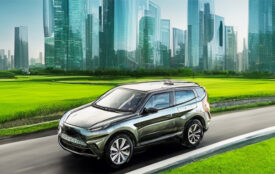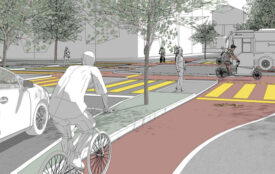What role does green electricity play in charging electric cars?
A new study by Fraunhofer ISI addresses the question of how widespread green electricity contracts are among users of electric vehicles in Germany.
The study made a detailed examination of the share of green electricity contracts for charging at home, at work, and at public charging stations as well as the environmental standard of the contracts. In addition, the figures for Germany were related to the EU average.
Electric vehicles have a key role to play in Germany meeting its climate targets – their climate footprint, however, depends heavily on the electricity used to charge them. If calculations are based on the CO2 emissions of the German power grid, various studies already show high savings of greenhouse gas emissions. If, on the other hand, the power used for charging them comes entirely from renewable sources, this reduces their carbon footprint by up to 75% compared to conventional vehicles – and significantly improves their actual environmental balance.
Against this background, a team of authors from Fraunhofer ISI and the ESA² GmbH have conducted a survey of a total of 867 users of electric vehicles in Germany about their preferred charging location, and whether they rely on green electricity when charging.
Green electricity contracts are widespread among users of electric vehicles
The results show that 59% of those questioned in Germany prefer to charge their electric vehicle at home (EU average: 64%). Of the electric vehicle users, 84% have a green electricity contract (EU: 63%), which is significantly higher than the average for German households; only 30% of these had such a contract in 2020. The reasons for the high share of green electricity contracts mentioned include a high degree of environmental awareness among electric vehicle users and the government subsidy for home charging points, which in 2021 was linked to signing a green electricity contract.
However, according to the fleet managers surveyed, charging at the workplace, which applies to 14% (EU: 18%) of charging processes, is also linked to green electricity contracts with a similar frequency (D: 81%; EU: 60%). This is also true for public charging stations, as the analysis of various data sources shows: The contractually agreed green electricity share at normal public charging points in Germany is at least 85% (EU: 62%) and at least 75% (EU: 57%) at rapid public charging stations. The share of green electricity contracts is therefore very high at all three charging locations in Germany.
Varying standard of green electricity contracts
There are major differences, however, in terms of the environmental standards of the green electricity contracts. For instance, offers can be based exclusively on guarantees of origin; here, as a rule, old renewable power plants are assigned to the green electricity contract that have no connection to the location of electricity purchase and offer no temporal correlation between generation and demand. In contrast, there are also ambitious green electricity contracts with high environmental standards, which are verified via externally certified green power labels. Many of those surveyed did not provide any information about the labels or simply did not know anything about them. This could be due to the varying requirements and the large number of different labels. Government guidelines could create greater transparency here and a higher acceptance of ambitious green electricity contracts.
Prof. Martin Wietschel, Head of the Competence Center Energy Technology and Energy Systems at Fraunhofer ISI, points out that users of electric vehicles “often own a photovoltaic system with its own electricity storage that they use for charging in addition to green electricity contracts. Among those surveyed, 48%, so almost half, said they also owned a PV system”. According to Wietschel, 71% of respondents have also replaced a conventional passenger car with an internal combustion engine with an electric vehicle, which again underlines their high level of environmental awareness.
Development of green electricity contracts still open
According to Dr. Sabine Preuß, who coordinated the survey at Fraunhofer ISI, it is still open how the share of green electricity contracts, PV systems and battery storage will develop in future in view of the rising number of electric vehicle registrations. “It is conceivable that the share of green electricity in charging will continue to increase, because this becomes the social norm and has a decisive influence on environmental awareness. It is equally conceivable, however, that the share of renewable electricity contracts will decrease as, at the same time, the proportion of people increases who have fewer possibilities to rely on self-generated renewable power when charging electric vehicles – for instance, because they live in rented apartments and are not able to install a PV system.” In this case, charging at work and at both rapid and normal public charging points could increase, and the green electricity tariffs that apply here could become more important for the environmental footprint of electric vehicles. Here, too, further government guidelines could lead to a higher share of green electricity.
Future studies should take into account that more and more electricity tariffs are currently coming onto the market that are designed exclusively for charging electric vehicles. For electric vehicles to have a positive greenhouse gas balance, these should be based on green electricity that meets high environmental standards.
Source
Fraunhofer-Institut für System- und Innovationsforschung ISI 2022








